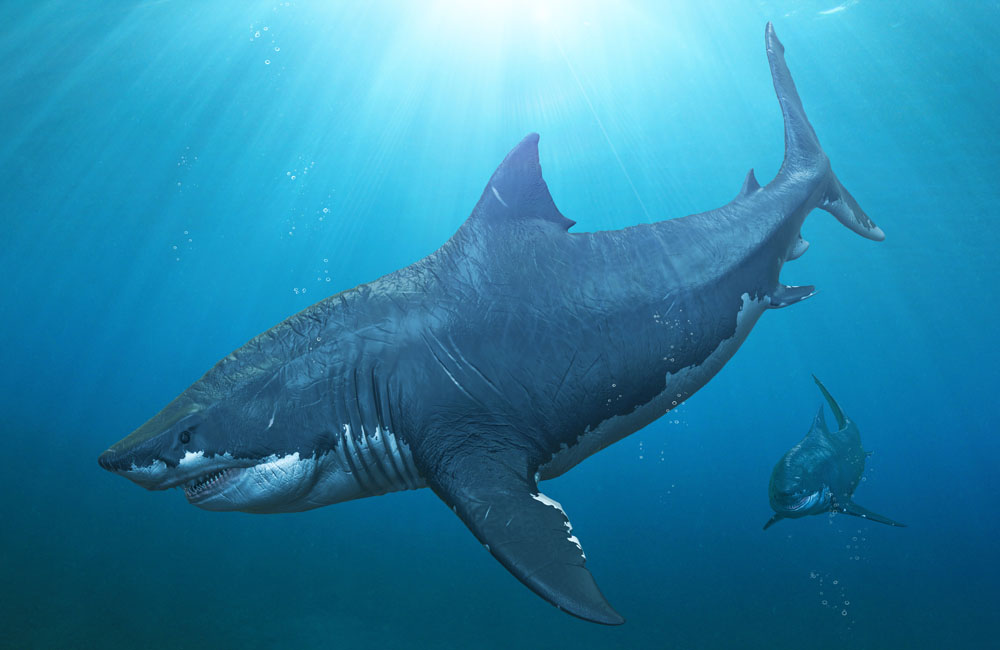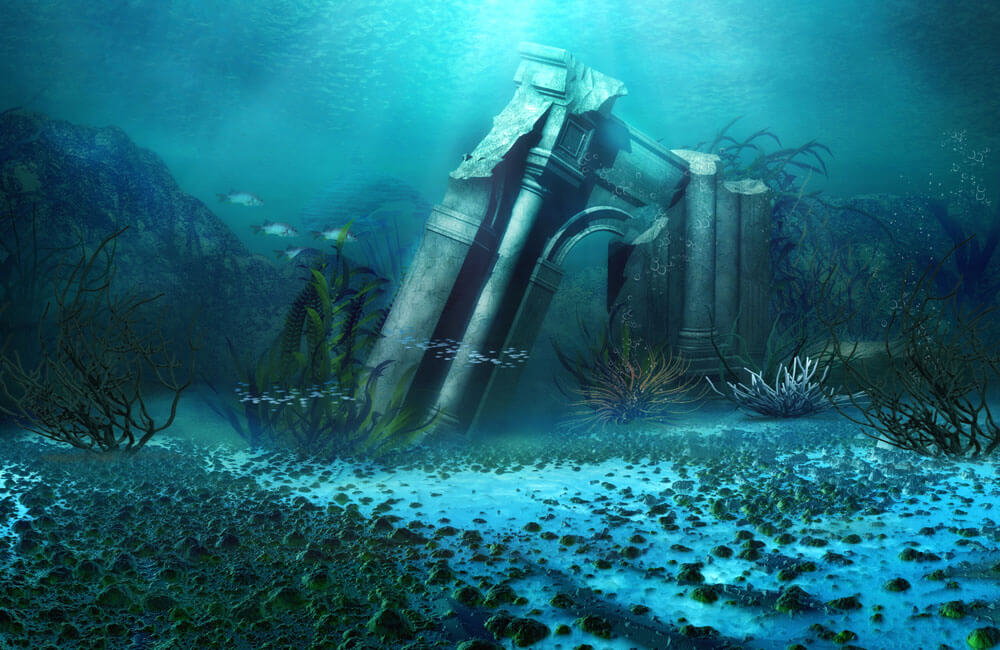
Underwater myths and legends, such as our April Fool’s story this year – the first scuba dive on the Titanic – are always popular reads, although it’s unlikely anybody reading the Titanic story was actually fooled, especially scuba divers. Nevertheless, there’s so much we don’t know about our ocean that even deliberately fake stories have become ‘true’ over the years.
The mysteries of the ocean and the fact that we can actively observe only a tiny portion of the underwater world at any given moment lends itself well to the imagination. Over the years, many myths and legends have arisen from the depths of the deep blue sea, some of them total nonsense, others based in reality. Science has moved forwards and we are better able to explain some of the stories but questions still arise, and thanks to the power of social media, many still believe them.
Here’s a selection of some of our favourite underwater myths, monsters and legends.
Megalodon

Megalodon was definitely a real shark, not an underwater myth, and its continued existence is one of the most commonly perpetuated myths of the aquatic realm. Because sharks are elasmobranchs, with skeletons made almost entirely of cartilage, very little of them remains in the fossil record save their teeth, and megalodon’s gigantic teeth (the name means exactly that) have been found around the world, measuring over 18cm in length. Although megalodon is usually portrayed as a larger version of the great white, it is currently thought to have had a body shape closer to the basking shark (a relative of the great white), up to 18m in length.
Megalodon is thought to have died out around 2.6 million years ago, relatively recently in geological terms. Early tool-making human ancestors are thought to have evolved at a similar time, however, any crossover between the species probably ended there. Controversy over the shark’s continued existence was raised in the late 1950s, when fossil megalodon teeth were dated at between 11,000 and 24,000 years old, giving rise to the possibility that megalodon may still be lurking somewhere in the deeper oceans. Scientific study of the fossils has since shown the dating techniques to be unreliable, and probably the result of the teeth being ‘redeposited’ – the process whereby fossils are eroded out of the rock in which they originally came to rest – and subsequently encased in a new material. More recent dating of the teeth places them at five million years old.

The inaccurate dating, however, has been used to put forward the idea that megalodon still exists, most recently in the 2014 Discovery Channel ‘documentary’ Megalodon: The Monster Shark Lives. Although the network promoted the show as a documentary, it was in fact entirely fictional, with paid actors playing the roles of the scientists. Discovery received a huge amount of backlash as a result, but the show nevertheless did the rounds on social media as ‘proof’ that the monster shark still lived.
While other large and mysterious creatures such as the giant squid remained elusive to cameras, their carcasses did occasionally wash up on shore, as opposed to Megalodon, which has never been observed either dead or alive, except in apocryphal sightings of large unidentified sea creatures. If further proof of its disappearance was required, a shark that size would have to feed on very large prey, dining on whales and dolphins, which to date have not been found with Megalodon’s 2.5m bite radius embedded in their carcasses. Megalodon, like most sharks, spent much of its life in shallow coastal water and was distributed worldwide, so the likelihood that it still exists – much as most of us really want it to – is, sadly, nil.
The Kraken

The Kraken is a mythical sea creature that may be based in reality, but in actuality, the legend of the kraken is more recent than the discovery of the giant squid, which many observers speculate to be at least partially responsible for the current version of the legend. Contrary to popular belief, mostly thanks to Hollywood, the kraken is not from the mythology of ancient Greece. They had their own – the Scylla – and sea monsters of varying forms are found in the folklore of many world civilisations. The legend of the kraken has its roots in Norwegian tales from the 13th century, the name derived from the old Norse word krake, meaning twisted or crooked, although originally it was called the hafgufa.It was originally described as a monstrous ‘crab-like’ creature, more than 1.5 miles wide in some stories, often appearing as an island in the sea.
The word ‘kraken’ doesn’t seem to turn up in print until Carl Linnaeus, the Swedish inventor of the modern binomial classification system, described it as a form of cephalopod, using the term Microcosmus marinus to identify it in the first edition of his Systema Naturae in 1735. Linnaeus removed the monster from further editions of the book, but the kraken was subsequently popularised by Erik Pontoppida, the Bishop of Bergen, in his 1752 book ‘The First Attempt at a Natural History of Norway‘.
By the 1800s, the kraken was almost universally described as what we now think of as the giant squid (Architeuthis), the first recording of which comes from Pliny the Elder, a Roman naturalist born in AD 23. The giant squid was, even until the 21st century, something of a myth all by itself. They had certainly been seen before, and may even have sunk some smaller boats.giving rise to the monster’s legend. Giant squid carcasses, measuring up to 14m long from the tip of their tentacles to the end of their mantles, turned up on beaches, and sperm whales were observed with the scars of suckers and hooks that resulted from what must have been titanic battles between two very large animals, although it is most definitely the case that the whales were preying on the squid, not the other way around.
It wasn’t until 2004 that a Japanese research vessel managed to land an intact, living specimen (it didn’t survive) and film Architeuthis attacking bait underneath the vessel. It wasn’t filmed again until 2012. It’s worth noting that the giant squid is merely the second largest living invertebrate known to exist. It is exceeded by the colossal squid (clearly they were running out of superlatives) which is thought to be about the same length but has a much larger body. The giant squids have the largest eyes known to science, measuring up to an estimated 40cm in diameter.
The Lost City of Atlantis

The ancient city – or island nation, actually – of Atlantis is another underwater myth that perpetuates in modern culture. Atlantis is part of the work of the legendary (but very real) Greek philosopher Plato, who lived during the 5th century BC. Whether the island is an entirely fictional product of Plato’s mind, used to demonstrate his ideas about the concept of a nation state, or not, is hotly debated by his own students. Aristotle, for example, a student of Plato, thought Atlantis was entirely allegorical. The less-well-known philosopher Crantor, a student of a student of Plato, thought that Plato had used a real story about a real place as a metaphor in his work.
Where Atlantis might be located has been the subject of many stories, debates and conspiracy theories, but it remains undiscovered, despite many claims to the contrary. Plato himself was rather vague, writing that Atlantis lay ‘beyond the pillars of Hercules’, or, in other words, the entrance to the Mediterranean sea, The northern pillar of Hercules is what we now know as the Rock of Gibraltar; the southern peak is somewhere in North Africa. Rather a lot lies ‘beyond the pillars of Hercules’ (such as the entire Atlantic ocean); Plato, clever chap though he might have been, never drew a map.
While Atlantis is most probably a fictional island, it is not entirely without factual origins. The mythology of great floods extends back thousands of years, probably back to the end of the last glacial period, which ended some 10,000 years ago, when naturally occurring changes in the climate would have resulted in a deluge of flood water and sea level rises from the melting glaciers. Volcanic activity, earthquakes, erosion, and the movement of the Earth’s tectonic plates are all responsible, and although Atlantis itself might not exist, there are other ruins that lie beneath the waves. You can even dive some of them.
One of the best known is Antirhodos, home of the palace of the Egyptian queen Cleopatra, which disappeared beneath the sea after a massive earthquake and subsequent tsunami struck Alexandria in AD 365. It was partly myth, partly legend, partly historical fact until scuba diving archaeologists located the remains of the city in 1996.
Mermaids

Mermaids are, as we all know, underwater creatures whose upper half is that of a human woman, with the lower half being the tail of a fish. There are also, technically, mermen, but since the overwhelming majority of sea-faring people in historical times were men, who spent a very, very, long time out at sea without female companionship, there are definitely more mermaids than mermen.
The legends of beautiful, (mostly) female sea-creatures are present in the mythologies of many diverse civilisations around the world, and the sirens of Greek mythology – beautiful young women who lured sailors to their deaths along the rocky shores of their island home, through their beautiful singing voices – have played a part in their modern portrayal.
Sightings of mermaids, like the Kraken, have been reported throughout the ages. Christopher Columbus, the chap who claimed to have ‘discovered’ America, reported spotting three of them during his voyages. It has been suggested that manatees and dugongs may have been behind the sightings – clearly, Columbus had spent a lot of time at sea.
Like megalodon, mermaid sightings have been reported up until the present day, and have been the subject of elaborate hoaxes. One of the best known was the ‘Feejee Mermaid,’ displayed by P.T Barnum’s famous circus, which later turned out to be constructed of monkey bones and papier maché. No other mythical sea creature has been represented in art and literature as much as the mermaid, but no scuba diver has ever seen one, with the exception of those held in captivity in large tanks at dive shows.
Penis-eating clam

Just last week – and before April Fools day – a story went viral on social media about a man who had tried to insert his private parts into a giant clam, which subsequently slammed shut and triggered an allergy to seafood, causing ‘severe breathing complications, vomiting, extreme swelling and low blood pressure.’
While there may be some chaps out there who have certain issues in that department – such as, for example, finding manatees and dugongs to be irresistibly attractive mer-women – the story is false. It was originally reported by a website and facebook group called WorldNewsDailyReport, a satirical ‘news’ site that has a ‘long history of publishing misinformation’, according to fact-checking organisation snopes.com.
Although many people – like the megalodon myth – wanted the story to be true, it turns out that the photograph of the victim is from a completely unrelated – but also somewhat bizzare – incident, depicting the swollen face of a man who was bitten by a cottonmouth snake after allegedly trying to kiss it.
There are, undoubtedly, many more things waiting to be discovered in the depths of the world’s oceans. It’s just a few short weeks since the discovery of a new species of shark, for example, and we know very little about some of the largest creatures found in the ocean, blue whales and whale sharks included.Sadly, the likes of megalodon and mermaids will take their place alongside the Loch Ness monster and Ogopogo and remain permanently ‘undiscovered’, much as we might want to believe.


